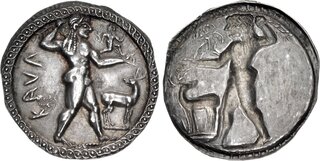Lot description:
BRUTTIUM, Kaulonia. Circa 525-500 BC. AR Nomos (30mm, 8.13 g, 12h). Apollo advancing right, holding branch aloft in right hand, left arm extended, upon which a small daimon, holding branch in each hand, runs right; KAVΛ to left; to right, stag standing right, head reverted; dot-and-cable border / Incuse of obverse, but daimon in outline and no ethnic; radiate border. Noe, Caulonia, Group A, 2p (this coin); Gorini 3; HN Italy 2035; SNG ANS 141 (same dies); SNG Lloyd 571–2 (same dies); Bement 265 (same dies); Gillet 279 (same dies); Locker-Lampson 43 (same dies); Morgan 92 (same dies); Rhousopoulos 208 (same dies). Beautiful old cabinet tone, with a faint iridescence, usual spot of die rust on obverse (diagnostic for die). EF. A lovely example of this issue, with an outstanding pedigree.
From the Father & Son Collection. Ex Sheikh Saud Al-Thani Collection (Numismatica Ars Classica 126, 17 November 2021), lot 6 (hammer CHF 34,000); Patrick H.C. Tan Collection (Gemini VII, 9 January 2011), lot 60; Millenia Collection (Goldberg 46B, 26 May 2008), lot 5; de Guermantes Collection (Leu 86, 5 May 2003), lot 255; J. Hirsch XVII [FPL] (February 1907), no. 291; J. Hirsch XVI (5 December 1906), lot 159.
Kaulonia was founded in the 7th century BC by Achaean Greeks. The location, on the underside of Italy's "toe," has long since disappeared beneath the waves, but marine archaeologists have located more than 100 fluted columns, likely for a large shrine to Apollo, the deity depicted on the city's beautiful coinage. On this exceptional piece, Apollo's nude body is shown striding right, with a small winged daimon on his left arm; to his right stands a stag, sacred to both Apollo and his sister Artemis. The unusual fabric of this piece follows a style peculiar to Greek southern Italy in the archaic period: a broad, thin flan, obverse depicted in relief, the reverse repeating the obverse motif but incuse, and reversed. The reasons for the popularity of this fabric are poorly understood; some scholars have postulated a connection to the mathematician-philosopher Pythagoras, who was active in Italy during this period.
Estimate: 20000 USD |  |